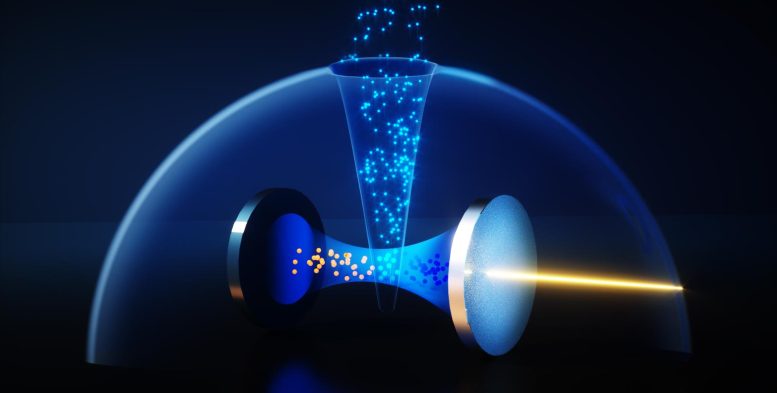
Artist’s visualization of a laser striking atoms in an optical cavity. Scientists discovered a new phenomenon called “collectively induced transparency” (CIT) where groups of atoms cease to reflect light at certain frequencies. The team found this effect by confining ytterbium atoms in an optical cavity and exposing them to laser light. At certain frequencies, a transparency window emerged in which light bypassed the cavity unimpeded. Credit: Ella Maru Studio
Newly Observed Effect Makes Atoms Transparent to Certain Frequencies of Light
Researchers at Caltech have discovered a new phenomenon, “collectively induced transparency” (CIT), where light passes unimpeded through groups of atoms at certain frequencies. This finding could potentially improve quantum memory systems.
A newly discovered phenomenon dubbed “collectively induced transparency” (CIT) causes groups of atoms to abruptly stop reflecting light at specific frequencies.
CIT was discovered by confining ytterbium atoms inside an optical cavity—essentially, a tiny box for light—and blasting them with a laser. Although the laser’s light will bounce off the atoms up to a point, as the frequency of the light is adjusted, a transparency window appears in which the light simply passes through the cavity unimpeded.
“We never knew this transparency window existed,” says Caltech’s Andrei Faraon (BS ’04), William L. Valentine Professor of Applied Physics and Electrical Engineering, and co-corresponding author of a paper on the discovery that was published on April 26 in the journal Nature. “Our research has primarily become a journey to find out why.”
An analysis of the transparency window points to it being the result of interactions in the cavity between groups of atoms and light. This phenomenon is akin to destructive interference, in which waves from two or more sources can cancel one another out. The groups of atoms continually absorb and re-emit light, which generally results in the reflection of the laser’s light. However, at the CIT frequency, there is a balance created by the re-emitted light from each of the atoms in a group, resulting in a drop in reflection.
“An ensemble of atoms strongly coupled to the same optical field can lead to unexpected results,” says co-lead author Mi Lei, a graduate student at Caltech.
The optical resonator, which measures just 20 microns in length and includes features smaller than 1 micron, was fabricated at the Kavli Nanoscience Institute at Caltech.
“Through conventional quantum optics measurement techniques, we found that our system had reached an unexplored regime, revealing new physics,” says graduate student Rikuto Fukumori, co-lead author of the paper.
Besides the transparency phenomenon, the researchers also observed that the collection of atoms can absorb and emit light from the laser either much faster or much slower compared to a single atom depending on the intensity of the laser. These processes, called superradiance and subradiance, and their underlying physics are still poorly understood because of the large number of interacting quantum particles.
“We were able to monitor and control quantum mechanical light-matter interactions at nanoscale,” says co-corresponding author Joonhee Choi, a former postdoctoral scholar at Caltech who is now an assistant professor at Stanford University.
Though the research is primarily fundamental and expands our understanding of the mysterious world of quantum effects, this discovery has the potential to one day help pave the way to more efficient quantum memories in which information is stored in an ensemble of strongly coupled atoms. Faraon has also worked on creating quantum storage by manipulating the interactions of multiple vanadium atoms.
“Besides memories, these experimental systems provide important insight about developing future connections between quantum computers,” says Manuel Endres, professor of physics and Rosenberg Scholar, who is a co-author of the study.
Reference: “Many-body cavity quantum electrodynamics with driven inhomogeneous emitters” by Mi Lei, Rikuto Fukumori, Jake Rochman, Bihui Zhu, Manuel Endres, Joonhee Choi and Andrei Faraon, 26 April 2023, Nature.
DOI: 10.1038/s41586-023-05884-1
Coauthors include Bihui Zhu of the University of Oklahoma and Jake Rochman (MS ’19, PhD ’22). This research was funded by the Department of Energy, the National Science Foundation, the Gordon and Betty Moore Foundation, and the Office of Naval Research.









Dark matter?